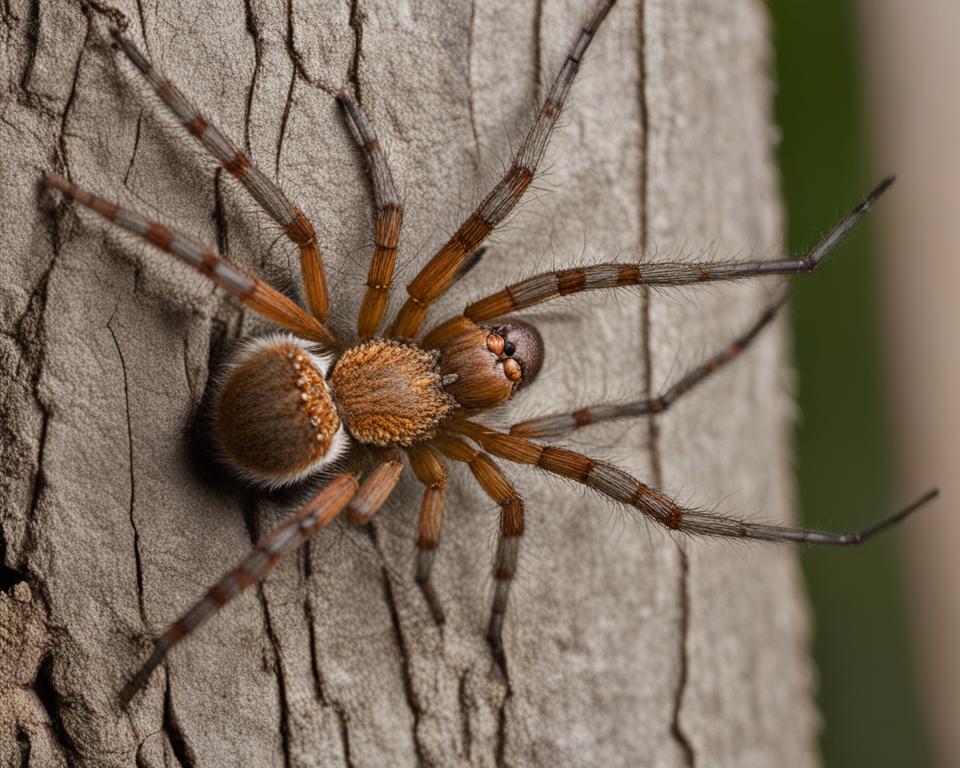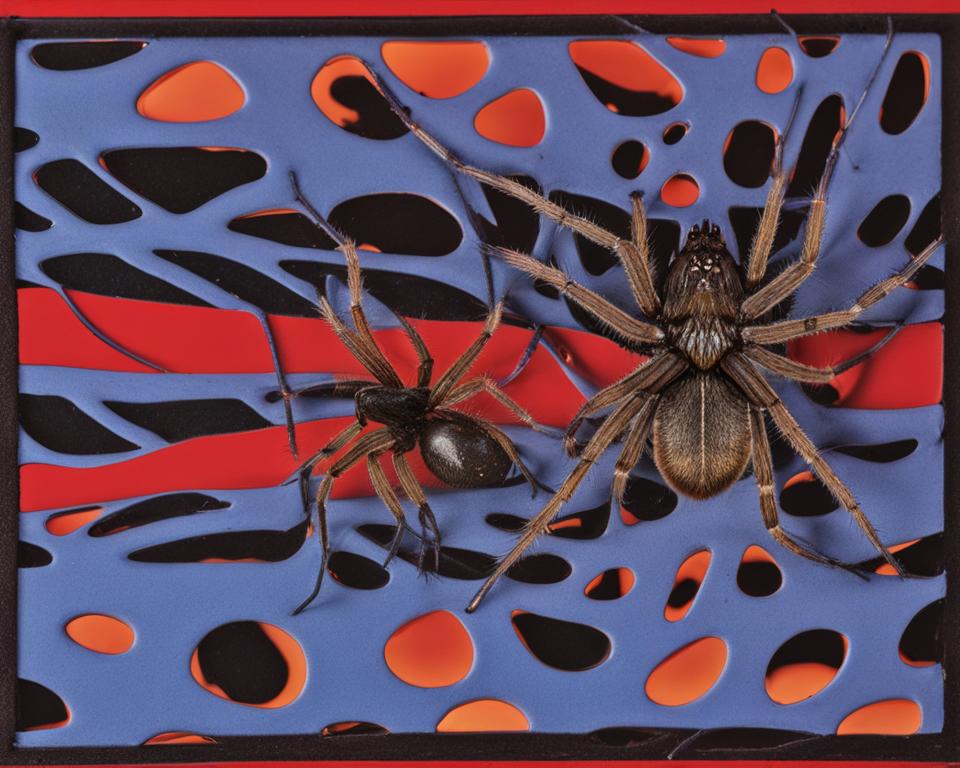Spiders are commonly found pests in households and identifying their species can be helpful in ensuring your safety. While both hobo spiders and house spiders are frequently found indoors, they have some distinct differences which aid in their identification.
In this section, we will explore the main differences between hobo spiders and house spiders. Understanding these distinctions will help with spider identification and enable you to take appropriate measures to protect yourself.
Key Takeaways
- Hobo spiders and house spiders have distinct physical and behavioral characteristics that differentiate them.
- Learning about the venom and bites of these spiders is crucial for your safety.
- Examining the habitat and typical behavior of these spiders will aid in identification.
- By understanding the differences between these spiders, you can better identify them and take appropriate measures.
Physical Characteristics
When it comes to identifying hobo spiders vs house spiders, examining their physical characteristics is key. Hobo spiders are typically larger than house spiders, with light brown markings on their bodies. They have a distinct “herringbone” pattern on their abdomens and eight hairy legs. House spiders, on the other hand, are usually smaller, with shorter legs and less noticeable markings on their bodies.
Another way to differentiate between the two is by looking at their eyes. Hobo spiders have two large, forward-facing eyes with four smaller eyes below them, giving them a “teardrop” appearance. Conversely, house spiders have eight similarly sized eyes, arranged in two rows of four.
Furthermore, hobo spiders have a thicker, hairier body compared to house spiders. They also have longer, more robust legs and a slightly curved abdomen. Alternatively, house spiders have a more compact body with shorter, thinner legs and a flatter abdomen.
Overall, taking note of these physical differences can help you distinguish between hobo spiders vs house spiders.
Habitat and Behavior
Hobo spiders and house spiders have different preferred habitats and behaviors. Understanding these factors can help identify which type of spider is present.
Hobo Spider
| Preferred Habitat | The hobo spider is commonly found in the Pacific Northwest region of the United States, where it prefers dry, cool environments. It often builds funnel-shaped webs in dark, sheltered areas such as basements, crawl spaces, and woodpiles. |
|---|---|
| Typical Behavior | Hobo spiders are active hunters that come out at night to search for prey. They are known for their aggressive behavior and will defend themselves if they feel threatened. If disturbed, they may run quickly to cover and may bite. |

House Spider
| Preferred Habitat | The house spider can be found worldwide and inhabits homes, gardens, and fields. It prefers warm, damp areas such as basements, attics, and bathrooms. |
|---|---|
| Typical Behavior | House spiders are web builders and are known for their distinctive, messy webs in the corners of rooms and ceilings. They are not aggressive and will usually run away when disturbed. Bites are rare and generally not dangerous. |
Knowing the preferred habitats and behaviors of hobo spiders and house spiders can help you identify which type of spider you are dealing with and take appropriate action.
Venom and Bites
Both hobo spiders and house spiders are known for their venomous bites. While not typically fatal, these bites can cause discomfort and other symptoms. Let’s explore further.
The venom of hobo spiders is particularly potent and can result in tissue damage around the site of the bite. This venom is also known to have neurotoxic properties, which can lead to additional symptoms such as headache, fatigue, and muscle pain.
House spiders, on the other hand, have venom that is much less harmful to humans. While a bite from a house spider may cause redness and swelling, it is not likely to cause any more serious symptoms.
If you do get bitten by a spider, it’s important to watch for any signs of an allergic reaction. Seek medical attention immediately if you experience difficulty breathing, swelling of the face or mouth, or hives.

Overall, it’s best to avoid handling spiders if possible, and to take measures to prevent them from entering your home. By understanding the differences between hobo spiders and house spiders, you can better protect yourself from potential bites and their associated risks.
Hobo Spider vs House Spider
After understanding the differences in physical characteristics, habitat, behavior, venom, and bites between hobo spiders and house spiders, you can better identify these spiders and take appropriate measures to ensure your well-being.
Remember, hobo spiders are typically found in the Pacific Northwest region, while house spiders are more prevalent in homes throughout the country. If you live in the Pacific Northwest, it is essential to learn about hobo spider identification and their habits.
Additionally, if you suspect a spider bite, seek medical attention immediately. Symptoms of a hobo spider bite can be severe, and quick treatment is necessary. House spider bites typically do not cause serious symptoms but should still be monitored and treated if necessary.
By understanding the differences between hobo spiders and house spiders, you can take appropriate measures to prevent spider encounters in your home or while outdoors. If you spot either spider, remain cautious and seek professional help if necessary.
Stay informed and stay safe!
FAQ
How can I differentiate between a hobo spider and a house spider?
Hobo spiders and house spiders can be differentiated by examining their physical characteristics, such as leg length, coloration, and body shape.
Are hobo spiders venomous?
Yes, hobo spiders are venomous. Their venom can cause tissue damage and potentially lead to necrotic wounds.
Are house spiders venomous?
House spiders are generally not considered medically significant and their bites are usually harmless to humans.
What habitats do hobo spiders prefer?
Hobo spiders are commonly found in dark, damp areas such as basements, crawl spaces, and outdoor vegetation.
Where do house spiders typically make their webs?
House spiders tend to construct their webs in quiet areas of homes, such as corners, ceilings, and attics.
What is the behavior of hobo spiders?
Hobo spiders are known to be aggressive and may bite when they feel threatened. They are nocturnal and actively hunt for prey.
How can I identify a house spider’s web?
House spiders weave irregular webs that are often messy in appearance. Their webs may contain loose threads and be located in secluded areas.
Can hobo spider bites be deadly?
While hobo spider bites can cause significant tissue damage, they are rarely life-threatening. Seek medical attention if you suspect you have been bitten.
What should I do if I find a hobo spider in my home?
If you encounter a hobo spider, it is recommended to contact a professional pest control service to safely remove the spider and address any potential infestation.
Are house spiders beneficial to have in my home?
House spiders play a crucial role in controlling other insect populations within your home. They help to reduce the presence of unwanted pests.
